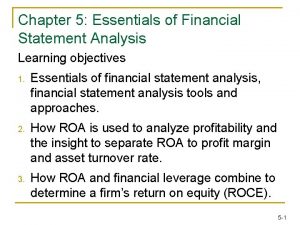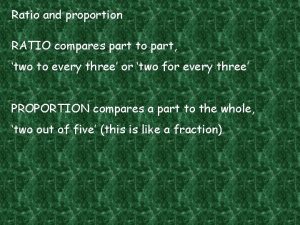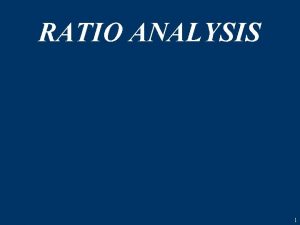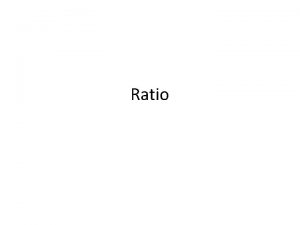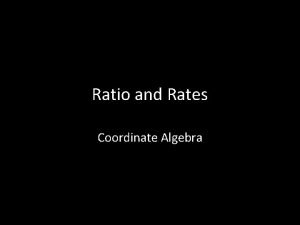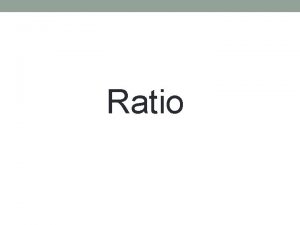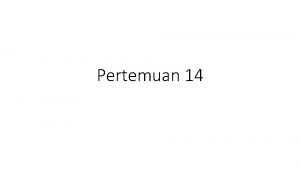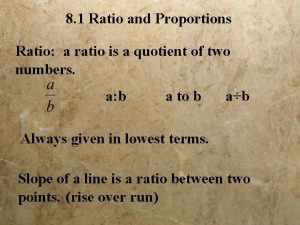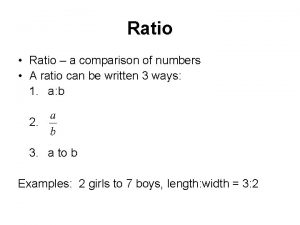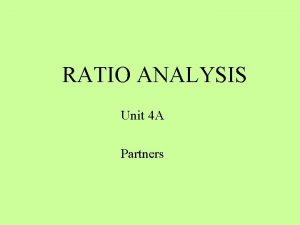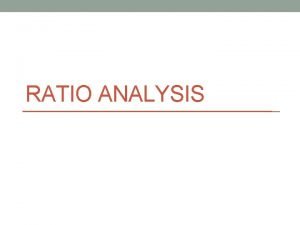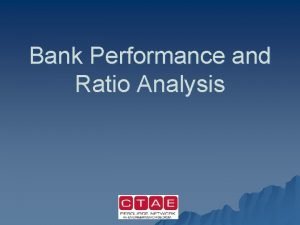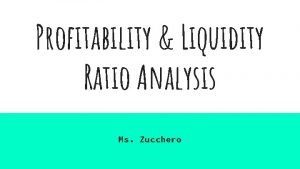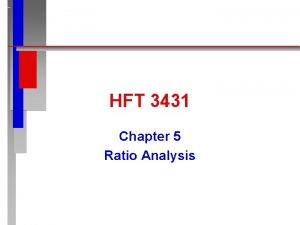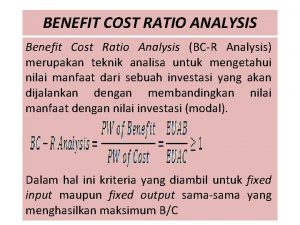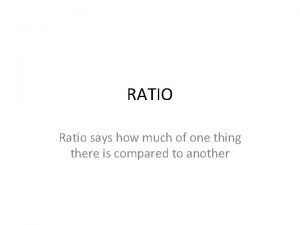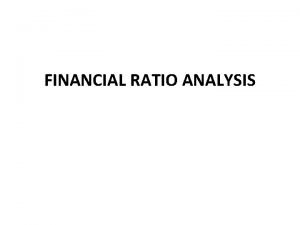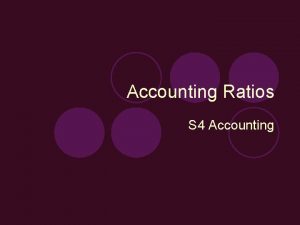Ratio Analysis Ratio Analysis It is one of


















![Operating Ratio Operating ratio= [(Cost of goods sold + Operating expenses / Net sales)] Operating Ratio Operating ratio= [(Cost of goods sold + Operating expenses / Net sales)]](https://slidetodoc.com/presentation_image_h2/07275c691fc763b9d7868d8f3041d92d/image-19.jpg)











- Slides: 30

Ratio Analysis

Ratio Analysis • It is one of the most important financial analysis tool • The organizational health is measured through financial analysis, which is an instrument that forecast the financial position by evaluating the financial statements • Organizational health refers to the capability of an organization to grow, develop and face competition in an effective manner

Ratio Analysis • Financial analysis is used by – Suppliers – Investors – Government

Ratio Analysis Liquidity Ratio Profitability Ratio Solvency Ratio • Current Ratio • Quick Ratio • Gross Profit Ratio • Net Profit Ratio • Return on Asset • Return on Equity • Operating Ratio • Debt Equity Ratio • Sort term Debt Ratio • Capital Gearing Ratio • Interest Coverage Ratio

Liquidity Ratio • Organization should maintain a proper coordination between its current and fixed assets • The liquidity of an organization is affected by number of factors – Type of Industry • Ex. Bank wants high liquidity and a service provider wants low liquidity – Inflation • If inflation is in the market than it requires high liquidity – Mode of Purchasing • If purchasing is on credit than it requires less liquidity – Business Life Cycle • During initial and growth stage it requires more liquidity – Type of Market • If organization operating in highly competitive market than it requires more liquidity • It evaluates the paying capacity of the organization in the short period of time

• Liquidity Ratios are – Current Ratio – Quick Ratio

Current Ratio • The current ratio is a reflection of financial strength. It is the number of times a company’s current assets exceed its current liabilities, which is an indication of the solvency of the business Current Ratio=Current Assets/Current Liability Current Assets = Stock, Debtor, Cash , Bank, Short term loan, Bills Receivable, Prepaid Expenses, Short-Term Investments Current Liability = Creditors, Bills Payable, outstanding expenses, Bank overdraft • • • A common rule of thumb is that a “good” current ratio is 2 to 1. It is effective but not followed blindly A current ratio can be improved by increasing current assets or by decreasing current liabilities. A high current ratio may mean cash is not being utilized in an optimal way. For example, the excess cash might be better invested in equipment.

Current Ratio • Ex: – Current Assets = 100000 – Current Liability = 50000 Current Ratio = 100, 000/50, 000 = 2 Or Current Ratio = 100000: 50000 = 2: 1 This means for every 1 rupee of asset company has to pay 0. 5 as its liability

Quick Ratio/Liquidity Ratio/Acid Test Ratio • It measures a company’s ability to meet its short term debts with the most liquid assets • Quick Ratio=Quick Assets/Quick Liability Quick Assets = Current Assets–Inventories-Prepaid Expenses Quick Liability = Current Liability – Bank Overdraft • In general it is advisable to have the quick ratio between 0. 5 to 1 • It measures the firm’s capacity to pay off current obligations immediately and is more effective test of liquidity than the current ratio

Quick Ratio • Ex Quick Assets = 50, 000 Quick Liability = 25, 000 Quick Ratio = Quick Assets/Quick Liability Quick Ratio = 50000/25000 = 2 OR Quick Ratio = 2: 1 This means for every 1 rupee of liquid asset company has to pay 0. 5 as its liquid liability

Example • Find the liquidity ratios of the business – Cash: $10, 000 – Accounts Receivable: $5, 000 – Inventory: $5, 000 – Bank balance: $1, 000 – Bills payable : $2000 – Prepaid taxes: $500 – Short-Term Investments = $5, 000 – Creditors: $15, 000

• Let's assume Carole's Clothing Store is applying for a loan to remodel the storefront. The bank asks Carole for a detailed balance sheet, so it can compute the quick ratio. Carole's balance sheet included the following accounts: – Cash: $10, 000 – Accounts Receivable: $5, 000 – Inventory: $5, 000 – Stock Investments: $1, 000 – Prepaid taxes: $500 – Current Liabilities: $15, 000

Profitability Ratio • Business is said to be profitable when its revenue generated from various business activities are exceed than the cost of investment • It shows a company's ability to generate profits from its operations • It can be used to judge whether companies are making enough operational profit from their assets

Profitability Ratio – Gross Profit Ratio – Net Profit Ratio – Return on Asset – Return on Equity – Operating Ratio

Gross Profit Ratio • Gross margin ratio is a profitability ratio that compares the gross margin of a business to the net sales • Gross Profit Ratio = Gross Profit/Net Sales • Ex : – Gross Profit = 250000 and Sales = 175000 – Gross Profit Ratio = 250000/175000 = 1. 4 – This means your gross profit is 1. 4 of every 1 rupee of sales

Net Profit Ratio • This ratio also indirectly measures how well a company manages its expenses relative to its net sales • Net Profit Ratio = Net Profit/Net Sales • Ex : – Net Profit = 500000 and Net Sales = 250000 – Gross Profit Ratio = 500000/250000 = 2 – This means your net profit is 2 of every 1 rupee of sales

Example • Find out gross and net margin of the business – Opening Stock – Purchase – Sales Return – Tax paid – Salary paid – Interest received 10000 120000 1000 500 1000 2000

Operating Ratio • This ratio is a test of the efficiency of the management in their business operation. It is a means of operating efficiency. • Lower the operating ratio, the better is the position because greater is the profitability and management efficiency of the concern.
![Operating Ratio Operating ratio Cost of goods sold Operating expenses Net sales Operating Ratio Operating ratio= [(Cost of goods sold + Operating expenses / Net sales)]](https://slidetodoc.com/presentation_image_h2/07275c691fc763b9d7868d8f3041d92d/image-19.jpg)
Operating Ratio Operating ratio= [(Cost of goods sold + Operating expenses / Net sales)] × 100 Here , Cost of Goods sold = Opening stock + Net purchases + Manufacturing expenses - Closing stock OR = Net sales - Gross profit Operating expenses = Office and administrative expenses + Selling and distribution expenses

Return on Asset Ratio • The return on assets ratio measures how effectively a company can earn a return on its investment in assets. In other words, ROA shows how efficiently a company can convert the money used to purchase assets into net income or profits • A higher ratio is more favorable to investors because it shows that the company is more effectively managing its assets to produce greater amounts of net income

Return on Assets • ROA = Net Income(EAT) / Average Total Assets • If you have your return on asset ratio is 2%, than every rupee that a company invested in assets during the year produced Rs. 2 of net income.

Return on Equity • It measures the ability of a firm to generate profits from its shareholders investments in the company. In other words, the return on equity ratio shows how much profit each dollar of common stockholders' equity generates • ROE is also and indicator of how effective management is at using equity financing to fund operations and grow the company.

Return on Equity • Return on equity measures how efficiently a firm can use the money from shareholders to generate profits and grow the company. • Return on Equity = Net Profit after Tax. Preference Dividend(if any)/Average total share holder equity

You are required to calculate 1. Net Profit Margin 2. Return on Assets 3. Return on owners equity

Solvency Ratio • An organization can survive when it possess the ability to pay its debts and interest on time • Solvency ratio indicates that the business is able to pay its long term debts or not • It is most important factor that affects the trust of investors and creditors

Solvency Ratio • Solvency Ratio – Solvency Ratio = Total Assets/Total Liability – Lower the ratio of total liability to total asset more stable is the long term solvency position • Debt Equity Ratio – This ratio is calculated to measure the ratio of debts against the equity – Debt Equity Ratio= Total Debts/Total owner’s equity – A very high ratio is unfavorable for the business

Solvency Ratio • Equity Ratio – The ratio shows the relationship of owner’s fund to total assets – Higher the ratio better the solvency – Equity Ratio = Proprietor’s Fund/Total Capital • Short term Debt Ratio – This ratio indicates the companies short term debts as compared to total debt – Short term debt ratio= short term debt/total debt

Solvency Ratio • Capital Gearing Ratio – A company is said to be low geared if the larger portion of the capital is composed of common stockholders’ equity. On the other hand, the company is said to be highly geared if the larger portion of the capital is composed of fixed interest/dividend bearing funds – Capital Gearing Ratio = (Preference share capital + Debentures+ Other Borrowed Funds)/(Equity Share holder’s fund+ Reserves & Surplus-Losses)

Solvency Ratio • Interest Coverage Ratio – It indicates the firms ability to pay interest – Interest Coverage Ratio=EBIAT/Fixed Interest Charges – Higher the ratio more safe are the long term creditors • Earning Per Share – EPS = (Net profit after Tax-Preference Dividend)/No. of Equity Shares – Higher the ratio more profit the equity share holders will get

 One god one empire one emperor
One god one empire one emperor One one one little puppy run
One one one little puppy run One king one law one faith
One king one law one faith One empire one god one emperor
One empire one god one emperor One ford plan
One ford plan See one do one teach one
See one do one teach one One price policy
One price policy Twelfth night speeches
Twelfth night speeches See one do one teach one
See one do one teach one One vision one identity one community
One vision one identity one community Graphic organizer with the aims of la liga filipina
Graphic organizer with the aims of la liga filipina Othello scene 1 act 1 summary
Othello scene 1 act 1 summary Hazard ratio vs odds ratio
Hazard ratio vs odds ratio Mechanical advantage of gears formula
Mechanical advantage of gears formula Acid test ratio and quick ratio
Acid test ratio and quick ratio Fixed interval fixed ratio variable interval variable ratio
Fixed interval fixed ratio variable interval variable ratio Phenotypic ratio of dihybrid cross
Phenotypic ratio of dihybrid cross Perbedaan or rr dan pr
Perbedaan or rr dan pr Current ratio and quick ratio
Current ratio and quick ratio One ratio compares a part to a whole
One ratio compares a part to a whole One year ago the ratio of sooraj
One year ago the ratio of sooraj Through one man
Through one man One direction song one thing
One direction song one thing Place value of 300
Place value of 300 1 team 1 fight
1 team 1 fight One goal one passion
One goal one passion One gene one polypeptide concept
One gene one polypeptide concept Jean watson caring moment
Jean watson caring moment One voice one look
One voice one look One future world
One future world Use of ones
Use of ones


















